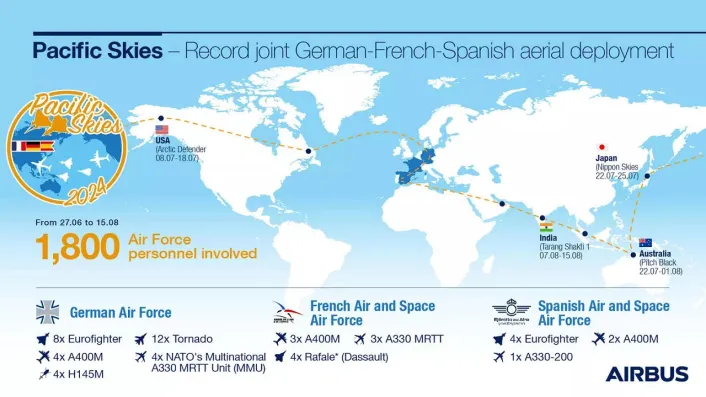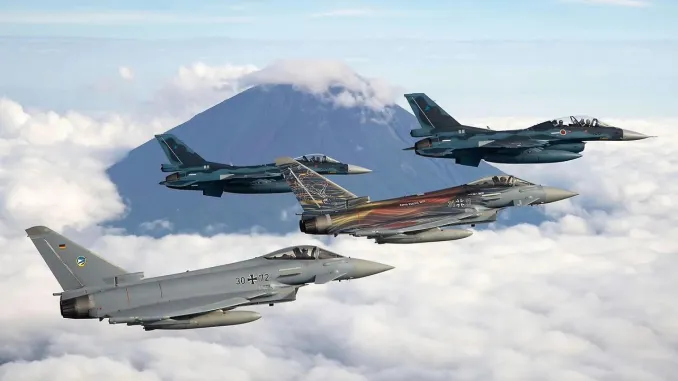A trinational contingent of 48 aircraft is deploying across the world to demonstrate air power projection and take part in multiple international exercises.
On Jun. 27, 2024, the French, German and Spanish Air Forces started the historic deployment that will take 48 of their aircraft across the world to train in the Indo- Pacific region. Dubbed Pacific Skies 2024, the deployment will allow the three air forces to take part in multiple international exercises with regional partners.
The 58,000-kilometre trip will stretch across four continents between Jun. 27 and Aug. 15, with four highlights: Arctic Defender in Alaska, Nippon Skies in Japan, Pitch Black in Australia and Tarang Shakti 1 in India. Germany will also take part in RIMPAC 2024 in Hawaii.
“By participating in Pacific Skies 24, we as Europeans are showing presence in a part of the world that is of great importance to all of us,” said Luftwaffe Chief of Staff Lieutenant General Ingo Gerhartz. “We will deploy to the Indo-Pacific region together with Spain and France and take part in five different exercises.”
✈️ The heat is on. 🔥#PacificSkies24 is about to begin. With the participation of 40 Airbus military aircraft, @Team_Luftwaffe, @Armee_de_lair & @EjercitoAire are conducting an unprecedented joint deployment in the Asia-Pacific region to demonstrate their air power.
Go to our… pic.twitter.com/1EivIRVIqx
— Airbus Defence (@AirbusDefence) June 26, 2024
While the official start of Pacific Skies was set for Jun. 27, the German Tornados were already in Alaska for a two-week low-level flying exercise from Jun. 17 to 29, in preparation for Artic Defender. Notably, Pacific Skies will be the last international appearance of the German Tornado fleet before its planned retirement.
The deployment involves a total of 48 aircraft, including twelve German Tornados, eight German and four Spanish Eurofighter, four French Rafales jets, four German H145M light helicopters, four German, two Spanish and three French A400M transport and refuelling aircraft as well as seven A330 MRTT (Multi Role Tanker Transport) aircraft.
An aspect that is being highlighted by all the participants is their cooperation for the FCAS (Future Combat Air System) program, which will develop the future sixth generation fighter aircraft for France, Germany and Spain. The deployment will allow to increase the interoperability of the three nations and further improve cooperation for joint training and cross-maintenance.
All decked out to steal the show – the ambassador #Eurofighter and #A400M of the Spanish air force bearing the official logo of #PacificSkies24 were revealed today.
From 27 June to 15 August, over 1.800 servicemen and women from 🇩🇪, 🇫🇷 and 🇪🇸 and as many as 28 combat aircraft and… pic.twitter.com/gXUUINMS1B
— Airbus Defence (@AirbusDefence) June 13, 2024
With the aim of having the smallest logistical footprint and maximum performance, the Spanish Air and Space Force and the German Luftwaffe will carry out shared maintenance of their Eurofighters and A400Ms as a perfect example of interoperability and cooperation between allied nations.
France, Germany and Spain are not the only European nations to deploy to the Indo-Pacific region this year. In fact, the United Kingdom, as explained later, will deploy with France to Australia for Exercise Pitch Black, while Italy is deploying both its Navy and Air Force to the area to take part in multiple exercises, notably Pitch Black, RIMPAC and joint training with Japan.
The deployment
As we mentioned, the first aircraft to deploy were the German Tornados, which left Germany on Jun. 13 and arrived at Joint Base Elmendorf-Richardson, Alaska, two days later. On Jun. 26 it was the turn of the Spanish aircraft to depart, with the first leg of their flight taking them from Albacete to Nörvenich, Germany.
Gelandet! Nach über 6 Stunden Flug und einigen Betankungen in der Luft, sind unsere, die 🇪🇸 Flieger und die der @A330_MMU (8 EF DEU, 4 EF ESP, 1 C130J DEU, 4 MMU A330 und 2 FRA A330) in Goose Bay sicher gelandet. #PacificSkies24 @EjercitoAire @Armee_de_lair pic.twitter.com/1BO4mwmTrq
— Team Luftwaffe (@Team_Luftwaffe) June 27, 2024
In fact, the following day, both German and Spanish assets took off from Nörvenich, escorted by four A330 MRTT tankers of the NATO MMF (Multinational MRTT Fleet). The aircraft were also visible on flight tracking websites and many were quick to notice a German Eurofighter turning back while over the U.K. and landing again in Germany, however the Luftwaffe was quick to clarify that the aircraft was a spare and returned back once it was not necessary anymore.
In the meanwhile, the French Rafales departed from Mont-de-Marsan and Saint-Dizier and, after a rendez-vous with two A330-MRTT Phénix tankers, they went on to begin the Atlantic crossing. As we will explain later, the French participation to Pacific Skies is part of the larger Pegase 24 mission.

Infographic about Pacific Skies 2024. (Image credit: Airbus)The first stop of the deployment is at CFB Goose Bay, Canada, where all aircraft landed after the Atlantic crossing. The aircraft will stay there for some joint training with the Royal Canadian Air Force, before resuming their travel and head to Alaska. Once there, they will take part in Exercise Arctic Defender from Jul. 8 to 17, together with U.S. forces.The most critical stretch, according to the head of Spanish Air Combat Command Chief, Lieutenant General Francisco González-Espresati, will be between Alaska and Japan, when the European aircrews will fly over the Pacific Ocean, close to Russian airspace. “It is envisaged that Russian aircraft will approach and intercept us,” he said. “We’re pretty sure they will, but we’re not worried about it.”
Unsere H145M Hubschrauber sind via Lufttransport mit einer Antonov AN124 in Fairbanks Alaska angekommen. Sie werden Teil der Übung #ArcticDefender24 im Rahmen von #PacificSkies24 sein. pic.twitter.com/ErweXNRGQb
— Team Luftwaffe (@Team_Luftwaffe) June 27, 2024
In Japan there will be multiple training events with the Japan Air Self-Defense Force, before the assets of the three participants will be split to take part in additional exercises in Japan (Nippon Skies), Hawaii (RIMPAC) and Australia (Pitch Black). The contingent will then head back to Europe with stops for exercises in Singapore, India and Qatar.
Germany
Germany is the lead nation for Pacific Skies 24, with the most aircraft deployed. As we already mentioned, the deployment will be the last international commitment of the German Tornado fleet, which the Luftwaffe plans to retire in 2025.
😳🤯!! Diese Aufnahmen toppen alles, was wir bisher im Tiefflug gesehen haben. Schaut Euch heute um 8 Uhr deutscher Zeit unser Tiefflugvideo auf unserem WhatsApp-Kanal in der exklusiven 😈Devil-Sneak-Preview-Version an, bevor wir es in der 👻Ghost-Version um 10 Uhr auf Instagram… pic.twitter.com/12vt9XIfJQ
— Team Luftwaffe (@Team_Luftwaffe) June 21, 2024
The German Air Force will practice its capability as so-called first responder to deploy rapidly and flexibly all over the world in a crisis. Training together with partners in the Indo-Pacific region will test and extend interoperability, such as the effective cooperation between the allied air forces.
In Japan the German Eurofighter fleet will split up: five jets will deploy further to Australia together with the French and Spanish crews to take part in the multinational exercise Pitch Black, while three German Eurofighters jets will stay in Japan to train together with the JASDF in the exercise Nippon Skies and other secondary events, the first time German fighter jets will train in Japanese air space.
A Tornado 🌪️ in Alaska? That’s right. With the arrival of the first German Tornado jets in Alaska, #PacificSkies24 has officially kicked off.
For @Team_Luftwaffe, it’s the largest and most demanding aerial deployment to date. In Alaska, the Tornados are training low level… pic.twitter.com/V1aobyIxBx— Airbus Defence (@AirbusDefence) June 19, 2024
At the end of the two exercises, these three jets will deploy to Hawaii to train together with the German Navy and international partners in the exercise RIMPAC. Meanwhile, the German-French team in Australia will further deploy to India, for the exercise Tarang Shakti Phase 1 led by the Indian Air Force.
Rafales refuel during the Atlantic crossing for Pacific Skies 2024. (Image credit: Armée de l’Air et de l’Espace – Morgane Vallé)
France
The Pacific Skies deployment of the French Air and Space Force will be part of the national Pegase 24, the yearly French mission in the Indo-Pacific region. In fact, the main deployment of Pegase 24 is divided in two: the first one towards the West with Germany and Spain as part of Pacific Skies, and the second one towards the East with the United Kingdom as part of Griffin Strike.
J-3 : Dans les starting blocks !#PEGASE2024@Armee_de_lair @EtatMajorFR @Armees_Gouv pic.twitter.com/SG1Wc78Neu
— Chef d’état-major armée de l’Air et de l’Espace (@CEM_AAE) June 24, 2024
As we already mentioned, the French contingent of Pacific Skies made a first stop at CFB Goose Bay, Canada, before continuing to Alaska for Exercise Arctic Defender. At the end of the exercise, the Rafales will fly to Japan with some joint training events with the JASDF, before moving to Australia for Pitch Black.
The second contingent will depart for Griffin Strike about a week later, on Jul. 6. Three Rafales, three A400Ms and three A330 MRTTs will join the Royal Air Force for a deployment which will take them to Australia, after stops in the United Arab Emirates and Singapore. In fact, the two French contingents will meet and participate together to Exercise Pitch Black.
🔴EN DIRECT | Décollage de la mission #PEGASE24 depuis la base aérienne 118 de Mont-de-Marsan. Direction l’Indopacifique avec l’@Armee_de_lair.
Cette année : deux routes, est et ouest, conjointement avec nos partenaires 🇩🇪, 🇬🇧et 🇪🇸.
Stay tuned🤘 https://t.co/sOBkIhm55s
— Armée française – Opérations militaires (@EtatMajorFR) June 27, 2024
At the end of the exercise, the first contingent will continue the Pacific Skies deployment with Germany and Spain, while the second will continue on its own with activities in the French territories in the Pacific and Indian Oceans, as well as exercises in Indonesia, Philippines, Singapore, Qatar and Egypt.
German and Spanish Typhoons after their arrival at CFB Goose Bay. (Image credit: Luftwaffe)
Spain
Pacific Skies is the first deployment of this kind for the Spanish Air and Space Force in its recent history. In fact, this is being considered as the most ambitious project of Spain since the Atlantic crossing of pioneering Spanish aviators in the 1920s.
¡Aviadores! 🌎✈️
Ya estamos en Goose Bay, Canadá.
El primer vuelo de larga distancia del #PacificSkies24 se ha realizado sin novedad y ya nos encontramos en Canadá, desde donde daremos el ‘salto’ a Alaska ❄️ para dar comienzo al ejercicio Arctic Defender. 😉 pic.twitter.com/L8Kbr41rBf
— Ejército del Aire y del Espacio (@EjercitoAire) June 27, 2024
Four Eurofighter C.16s (as the Typhoon is named in Spain), accompanied by two A400Ms and an A330 MRTT will follow along the two other nations as they fly around the world. Among the exercise milestones for the Spanish A400Ms are the return of an aircraft from Alaska over the North Pole, while a trip with French and Germans to New Zealand, the antipode of Spain, also stands out.
As we already mentioned, Spain and Germany will share the maintenance of the Eurofighter and A400M, as well as the logistics of the deployment. This will allow the two countries to improve their interoperability, as well as reducing the logistical footprint and increasing the efficiency.









